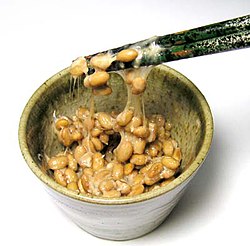Fermentation in food processing

Fermentation in food processing typically refers to the conversion of sugar to alcohol using yeast under anaerobic conditions. A more general definition of fermentation is the chemical conversion of carbohydrates into alcohols or acids. When fermentation stops prior to complete conversion of sugar to alcohol, a stuck fermentation is said to have occurred. The science of fermentation is known as zymology.
Fermentation usually implies that the action of the microorganisms is desirable, and the process is used to produce alcoholic beverages such as wine, beer, and cider. Fermentation is also employed in preservation to create lactic acid in sour foods such as pickled cucumbers, kimchi and yogurt.
History
Since fruits ferment naturally, fermentation precedes human history. Since prehistoric times, however, humans have been controlling the fermentation process. The earliest evidence of winemaking dates from eight thousand years ago, in Georgia, in the Caucasus area. Seven-thousand-year-old jars of wine have been excavated in the Zagros Mountains in Iran, which are now on display at the University of Pennsylvania. There is strong evidence that people were fermenting beverages in Babylon circa 5000 BC, ancient Egypt circa 3150 BC, pre-Hispanic Mexico circa 2000 BC, and Sudan circa 1500 BC. There is also evidence of leavened bread in ancient Egypt circa 1500 BC and of milk fermentation in Babylon circa 3000 BC.
French chemist Louis Pasteur was the first known zymologist, when in 1854 he connected yeast to fermentation. Pasteur originally defined fermentation as "respiration without air". Pasteur performed careful research and concluded;
The German Eduard Buchner, winner of the 1907 Nobel Prize in chemistry, later determined that fermentation was actually caused by a yeast secretion that he termed zymase.
Uses
The primary benefit of fermentation is the conversion of sugars and other carbohydrates, e.g., converting juice into wine, grains into beer, carbohydrates into carbon dioxide to leaven bread, and sugars in vegetables into preservative organic acids.
Food fermentation has been said to serve five main purposes:
- enrichment of the diet through development of a diversity of flavors, aromas, and textures in food substrates.
- preservation of substantial amounts of food through lactic acid, alcohol, acetic acid and alkaline fermentations.
- biological enrichment of food substrates with protein, essential amino acids, essential fatty acids, and vitamins.
- detoxification during food-fermentation processing.
- a decrease in cooking times and fuel requirements.
Fermentation has some uses exclusive to foods. Fermentation can produce important nutrients or eliminate antinutrients. Food can be preserved by fermentation, since fermentation uses up food energy and can make conditions unsuitable for undesirable microorganisms. For example, in pickling the acid produced by the dominant bacteria inhibit the growth of all other microorganisms. Depending on the type of fermentation, some products (e.g., fusel alcohol) can be harmful to people's health.
Stuck fermentation
A stuck fermentation is where a fermentation has stopped before completion; i.e., before the anticipated percentage of sugars has been converted by yeast into alcohol or carbohydrates into carbon dioxide.
Typically, a stuck fermentation may be caused by: 1) insufficient or incomplete nutrients required to allow the yeast to complete fermentation; 2) low temperatures, or temperature changes which have caused the yeast to stop working early; or 3) a percentage of alcohol which has grown too high for the particular yeast chosen for the fermentation.
Corrections to stuck fermentations may include: 1) repitching a different yeast 2) incorporation of nutrients in conjunction with the repitched yeast; 3) restoration of accommodative temperatures for the given yeast.
Fermented foods by region

- Worldwide: alcohol, wine, vinegar, olives, yogurt, bread, cheese
- Asia
- East and Southeast Asia: amazake, asinan, bai-ming, belacan, burong mangga, com ruou, dalok, doenjang (된장), douchi, jeruk, lambanog, kimchi (김치), kombucha, leppet-so, narezushi, miang, miso, nata de coco, nata de pina, natto, naw-mai-dong, pak-siam-dong, paw-tsaynob in snow (雪裡蕻), prahok, ruou nep, sake, seokbakji, soy sauce, stinky tofu, szechwan cabbage (四川泡菜), tai-tan tsoi, chiraki, tape, tempeh, totkal kimchi, yen tsai (醃菜), zha cai (榨菜)
- Central Asia: kumis (mare milk), kefir, shubat (camel milk)
- India: achar, appam, dosa, dhokla, dahi (yogurt), gundruk, idli, mixed pickle
- Africa: fermented millet porridge, garri, hibiscus seed, hot pepper sauce, injera, lamoun makbouss, laxoox, mauoloh, msir, mslalla, oilseed, ogi, ogili, ogiri
- Americas: chicha, elderberry wine, kombucha, pickling (pickled vegetables), sauerkraut, lupin seed, oilseed, chocolate, vanilla, tabasco, tibicos
- Middle East: kushuk, lamoun makbouss, mekhalel, torshi, boza
- Europe: rakfisk, sauerkraut, ogórek kiszony, surströmming, mead, elderberry wine, salami, prosciutto, cultured milk products such as quark, kefir, filmjölk, crème fraîche, smetana, skyr.
- Oceania: poi, kaanga pirau (rotten corn), sago
Fermented foods by type
Bean-based
cheonggukjang(청국장), doenjang(된장), miso (味噌(みそ)), natto(納豆(なっとう)), soy sauce, stinky tofu(臭豆腐), tempeh
Grain-based

amazake, beer, bread, choujiu, gamju(감주), injera, makgeolli, ogi, sake, sikhye, sourdough, rice wine, Malt whisky, grain whisky, Vodka, batter
Vegetable-based
kimchi(김치), mixed pickle, sauerkraut
Fruit-based
Honey-based
Dairy-based
cheese, kefir, kumis (mare milk), shubat (camel milk), cultured milk products such as quark, filmjölk, crème fraîche, smetana, skyr, yogurt
Fish-based
bagoong, faseekh (ﻓﺴﻳﺦ), fish sauce, Hákarl, heshiko, hidal khunda[verification needed], jeotgal (젓갈), rakfisk, shrimp paste, surströmming
Meat-based
Risks of consuming fermented foods
Alaska, despite its small population, has witnessed a steady increase of cases of botulism since 1985. It has more cases of botulism than anywhere else in the United States of America. This is caused by the traditional Eskimo practice of allowing animal products such as whole fish, fish heads, walrus, sea lion and whale flippers, beaver tails, seal oil, birds, etc., to ferment for an extended period of time before being consumed. The risk is exacerbated when a plastic container is used for this purpose instead of the old-fashioned method, a grass-lined hole, as the botulinum bacteria thrive in the anaerobic conditions created by the plastic.[citation needed]
